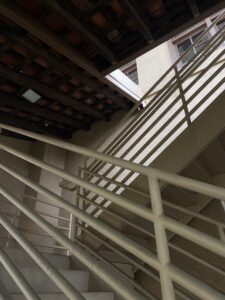
This past spring, University of California students voiced their concerns about the UC system’s shortcomings related to disability services. The UC Student Association has put out statements showing the need to spend exponentially more on university disability services as students face unreasonable wait times and their accommodations go unmet. At UC Riverside, the problem expands beyond the capabilities of the Student Disability Resource Center as ableism has permeated everything from the university’s architecture and housing to classroom accommodations.
In the UC system, there is a widespread staff shortage at student disability resource centers. This can’t be blamed on the SDRC staff as they, like specialists at many higher education institutions, try to meet a growing amount of accommodations without the funding they need to do it. At UCR, the disabled student-to-specialist ratio is higher than in any other recorded UC, with a ratio of 600 students to 1 specialist. UCR, like most other UCs, runs on the quarter system, which puts students in 10-week courses and severely limits the time frame to get accommodations approved. With this quick period of time, in addition to the lack of staffing, there is an unreasonable demand put on SDRC employees.
UCR’s physical campus also fails to meet the needs of disabled students. When it comes to older buildings on campus, accessibility is a joke. Accessing lecture halls and classrooms should not be the hassle that it is, and students who need to use those entrances should not have to take a roundabout route simply to attend class. Accessible entrances should be the standard, and there needs to be serious and widespread revamping in order to accommodate this.
UCR Housing also offers limited options for accessibility needs. While the dormitory living communities, including Lothian, Dundee, Aberdeen-Inverness and Pentland Hills, have accessible entrances and elevators, the other on-campus housing options fail to meet the same standard. On-campus apartment options for disabled students are extremely limited to a blatantly unfair degree. Bannockburn, Plaza, Falkirk and Oban living communities all contain stairs and unleveled pavement, making it impossible to house disabled students.
The Glen Mor Housing community is the only non-third-party housing community offering accessible apartments on campus. Unfortunately, of the three most disability-accessible buildings in Glen Mor, the first floors of those buildings are allocated to honors and transfer students. Students who need disability-friendly living spaces are also often housed in old Glen Mor, the portion of the apartment complexes that can only be accessed through a series of hills and windy roads.
As UC schools grapple with the need to meet mental health and disability accommodations, there are questions as to why certain elements of online education that were prioritized during the height of the pandemic have not been incorporated into current curricula. COVID-19 demanded the introduction of an online learning model that became a hybrid learning plan, one that gave disabled students flexibility with their needs. While the return of in-person learning was something to be celebrated, it meant universities went back to ignoring the problems faced by students in need of accommodations.
Approximately one in eight American college students have a disability. A huge portion of colleges, and post-pandemic students and universities are seeing an uptick in the number of students who need accommodations, academic or otherwise, and it is stretching staff and students thin. The developments made with online learning during the spread of COVID-19 need to be made available to the students who need them. Closed captioning for lectures, being able to watch recorded lectures and not having to traipse all over campus should be the norm. Universities have the tools to do better for their campus communities, and they are deliberately choosing not to.
The UC system is also creating campuses where targeted populations are made to feel as though they do not belong. The UC’s own 2020 Undergraduate Experience Survey found a shocking disparity between disabled and able students. While 86% of students without a disability found that they felt they belonged on their UC campus, only 74% of disabled students could say the same. It is the responsibility of universities to ensure their campuses facilitate equity and inclusion, and this survey clearly indicates that they haven’t.
The Americans with Disabilities Act and the Rehabilitation Act of 1973 demand that universities create an environment that offers equal opportunities to all of its students, regardless of whether they are disabled or not. It is not just the moral responsibility of higher education institutions to do so; it is a legal one. This is the obligation of universities, or it would be plainly inaccurate to call themselves an educational institution.








